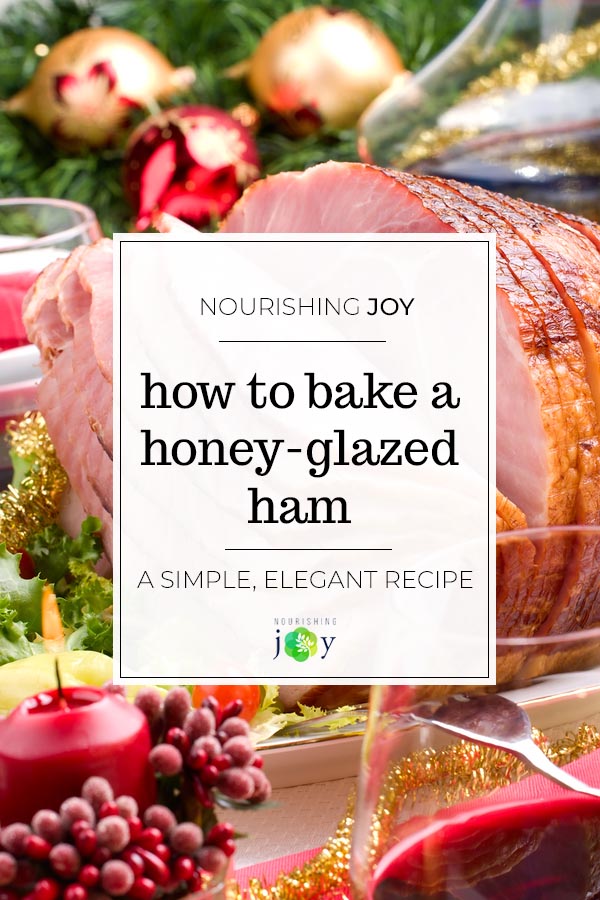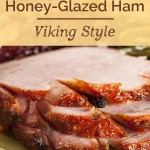Honey-Glazed Ham (Viking Style)
This post may contain affiliate links, including those from Amazon.com, which means we earn a small commission off your purchases. And here's the thing: We only mention services and products that we think are truly worth your attention, whether they're free, paid, or otherwise. This site relies on YOUR trust, so if we don't stand behind a product 110%, it's not mentioned. Period.



Like this recipe? Be sure to follow our Real Food Recipes board on Pinterest!
Whether it's Easter, Christmas, or just Sunday brunch, there's nothing as easy as a honey-glazed ham to feed a crowd (or just make you feel good).
And that's nothing new, as curing hams and preserving pork with salt and smoke has been part of many cultures and traditions for centuries, including the Scandinavian Vikings. (Perhaps a surprising mention from a culinary standpoint, eh?)
And these particular spices, which have been attributed to the Viking culinary tradition, create a delectable glaze that blackens just slightly when it's caramelized right at the end of cooking.
It's one of those recipes in my recipe binder that has stains on the page and lists of all of the occasions for which I've made it. Treasured, for sure.
Now, just a note about cooking ham. For the sake of this recipe, I assume you are starting with a cured, precooked ham. These are the most common type in North American supermarkets and are typically marked as “ready to cook”, “partially cooked” or “ready to serve.” It should NOT labelled as a country ham, which is the American version of prosciutto and quite a different beast (well, no, same beast, different preparation! 🙂 )
Also, for quality, be sure yours says “No Water Added” or “Plain Ham.” “Traditionally brined” is fine, but you don't want any injected brine, as that merely adds to the water weight. (If it just says “brined,” you can assume it was injected.)
As for cut, it's your choice. I usually find a spiral cut ham to be extra convenient, but a whole ham is absolutely fine as well. In fact, a whole ham is easier to score, so it makes the recipe preparation easier, while spiral cut makes serving easier, so the choice is absolutely up to you.
COOK TIMES FOR HAM:
As with most roasts, low and slow is best to keep the meat moist. However, hams can withstand higher temperatures if you don't overcook them.
- At 250°F, cook for 25-30 minutes per pound.
- At 300°F, cook for 15-18 minutes per pound.
- At 350°F, cook approximately 10-12 minutes per pound.
- The ham is ready for basting when it has reached an internal temperature of 130°F and is ready to serve at 140°F.



Honey-Glazed Ham – Viking Style
Ingredients
- 1 cooked ham, bone-in OR spiral ham
- 3 tablespoons juniper berries, crushed
- 1 pint dark beer or water
- 2 cups honey
- 2 tablespoons Dijon-style mustard
- 5 sprigs thyme, leaves picked off
- 1 tablespoon grated fresh ginger, optional
Instructions
- Plan your cook time according to the chart below and plan accordingly, then preheat the oven to the desired temperature.
- Remove the ham from all its packaging, including any plastic disks that may be inserted in the bottom.
- Place the ham flat-side down (if there is a flat side) in a large roasting pan, then using a very sharp knife, score the ham in a cross-hatch pattern. You'll want to cut through any fat layer and slightly into the muscle itself. Pour the beer over the ham, then try to rub the crushed juniper berries into the score marks. It will want to fall off, so just rub it in as much as you can.
- Tent the pan tightly with several layers of aluminum foil and place in the oven.
- Meanwhile, stir the honey, mustard, thyme leaves, and ginger together in a small saucepan and set aside. Just before glazing, heat the mixture over medium-low heat and keep warm.
- Roast until the ham registers 130°F at the thickest part of the meat, then pull the ham from the oven, remove the foil, and increase the oven temperature to 425°F.
- Pour the honey mixture all over the ham, trying to cover every exposed surface.
- Return the ham to the oven for about 10-15 minutes, removing it earlier if any part of it begins to smoke. If desired, place it under the broiler for 1-2 minutes at the very end to caramelize the very edges.
- Remove from the oven and let stand for 10-15 minutes. Place on a large serving platter or large cutting board and slice as desired.
- (And be sure to save the bone when you're finished for a lovely pot of bean soup.)
Notes
COOK TIMES FOR HAM:
As with most roasts, low and slow is best to keep the meat moist. However, hams can withstand higher temperatures if you don't overcook them.- At 250°F, cook for 25-30 minutes per pound.
- At 300°F, cook for 15-18 minutes per pound.
- At 350°F, cook approximately 10-12 minutes per pound.






this sounds so good. Viking is in my heritage, only problem is I have an allergy to juniper. I may try this anyway and just take extra allergy meds……lol
Or skip it! It’s just for flavor – the honey-glaze is lovely even without the juniper. 🙂
Sounds amazing! Are you using dried Juniper berries?
Yes, I usually use dried, but fresh can work as well. 🙂
Could this be done in a slow-cooker?
Definitely! You just wouldn’t get the glazing effect unless you put it under the broiler briefly with the glaze just before serving.
Yum! Enjoy!
We made this for Easter and it was fabulous. We didn’t have juniper, so used rosemary in the glaze to still add that earthy element. Everyone raved about the ham!